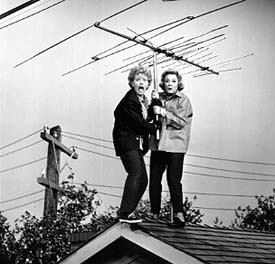Here I write down which point to tack care during antenna installation which including Wind load, Work Temperature and Humidity and Camouflaged Antenna Scheme for Sites
Wind Load
The antennas are usually installed on high buildings or towers. In the littoral areas, the wind is strong with high speed, so the antennas are required to work normally under a wind speed of 36 m/s and to keep complete under a wind speed of 55 m/s.
The antenna can usually resist strong wind. In some windy areas, the antennas are damaged due to unstable tower and pole, so you shall choose the antennas with small surface area.
Work Temperature and Humidity
The antenna of eNodeB shall work in a temperature of –40°C to +65°C and a humidity of 0 to 100%.
Lightning Protection
A direct DC connection of each RF input ports of antenna to the ground is required.
Three-proof Capability
The antenna of eNodeB must capable of damp-proof, salt mist-proof, and leaf mold-proof. For an omnidirectional antenna, it can also be installed bottom up and meet the three-proof capacity.
Camouflaged Antenna Scheme for Sites
A camouflaged antenna is beautiful, hidden, and according with technical requirements. The camouflaged antenna aims to keep consistent with the environment and to avoid being noticed so that the mobile communication project proceeds smoothly. The camouflaged antenna applies for urban site construction and coverage solutions for top grade residence area.
There are no fixed modes and methods for antenna camouflage. The antenna camouflage changes to flexible forms in different scenarios. The antenna camouflage aims to hidden it in the environment. You can choose proper beautification modes according to the environment for actual installation. The following paragraphs focus on some antenna camouflage schemes.
The antenna camouflage includes the following types:
- Customized camouflage
- Outlook camouflage
- Camouflage in special environment
Points to Take Care During Antenna Installation
1. Placement
Ensure the antenna is installed in an open area with minimal obstructions. For example, installing it on a rooftop away from walls or trees will reduce interference and improve signal reception.
2. Height
Install the antenna at an appropriate height to avoid obstacles and maximize coverage. A higher antenna, like on a tall pole, will usually get a better signal, especially for long-range communication.
3. Orientation
Make sure the antenna is correctly oriented for the best signal. For example, if you’re using a directional antenna, point it directly toward the signal source to get maximum performance.
4. Grounding
Properly ground the antenna to protect it from lightning strikes. Connect a grounding wire to the antenna’s base and ensure it’s linked to a good earth ground to prevent damage.
5. Avoid Interference
Install the antenna away from sources of electromagnetic interference, like power lines or large metal structures. For example, placing an antenna near a metal roof can cause signal distortion.
6. Cable Routing
Route the antenna cable carefully to avoid unnecessary bends or stress. For instance, avoid tight corners and use weatherproof connectors to ensure the cable doesn’t degrade over time.
